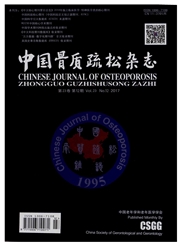

 中文摘要:
中文摘要:
目的:探讨低剂量镉暴露对大鼠破骨细胞形成的影响。方法24只Sprague-Dawley雄性大鼠随机分成3组,通过饮水进行镉染毒,染毒剂量为2 mg/L和10 mg/L;对照组饮水中加入相同体积的生理盐水。染毒后第24周,收集血液、腰椎及两侧胫骨,分别用于血抗酒酸酸性磷酸酶5b测定、骨密度测定及组织形态分析。通过酶组织化学染色,观察大鼠胫骨破骨细胞形成情况。结果染毒组大鼠骨密度较对照组有不同程度下降,其中高剂量组大鼠骨密度和对照组相比有显著差异(P<0.05)。骨组织形态分析显示镉作用后大鼠胫骨骨髓腔增宽,骨小梁数量及骨小梁连接明显减少。组织化学染色显示镉染毒可以增加大鼠胫骨破骨数量及面积,和对照组相比有显著差异( P<0.05)。染毒组大鼠血抗酒石酸酸性磷酸酶5b水平显著高于对照组( P<0.05)。结论低剂量镉染毒能增加大鼠骨组织内破骨细胞数量,骨吸收的过度活跃可能是低剂量镉骨损害的重要途径。
 英文摘要:
英文摘要:
Objective To investigate the effect of long-term, low-dose exposure of cadmium ( Cd ) on the formation of osteoclasts in rats.Methods Twenty-four male Sprague-Dawley rats were randomly divided into 3 groups.Rats were treated with Cd via drinking water at the concentration of 0, 2, or 10 mg/L for 24 weeks.The same volume of normal saline was additioned into the water in the control group.After 24 weeks, all the rats were sacrificed.The blood, the lumbar vertebrae and the bilateral tibias was collected for the detection of tartrate resistant acid phosphatase 5b (Tracp5b), bone mineral density (BMD) determination, histolmorphometry.The enzyme histological staining was used for the observation of osteoclasts formation in the rat tibia.Results BMD of rats in Cd-treated group was lower than that in control group, and the decrease in 10 mg/L group was statistically significant ( P〈0.05 ) .Bone histomorphometry showed that after the intervention of Cd, the marrow cavity in the rat tibia broadened, and the number and the connection of the bone trabecula reduced significantly.Histochemical investigation indicated that Cd could increase the number and area of osteoclasts in the rat tibia, and the difference was significant (P〈0.05).The Tracp 5b levels in Cd-treated groups were significantly higher than that in control group ( P〈0.05 ) .Conclusion Long-term, low-dose exposure of Cd can stimulate osteoclast formation.And excessive bone resorption medicated via osteoclasts may be an important way of Cd toxic effect on bone.
 同期刊论文项目
同期刊论文项目
 同项目期刊论文
同项目期刊论文
 The association between blood pressure and blood cadmium in a Chinese population living in cadmium p
The association between blood pressure and blood cadmium in a Chinese population living in cadmium p 期刊信息
期刊信息
